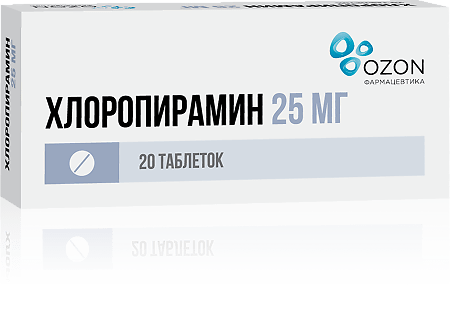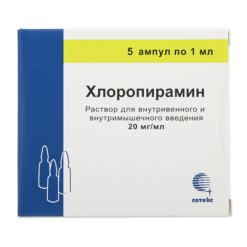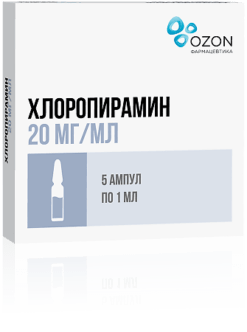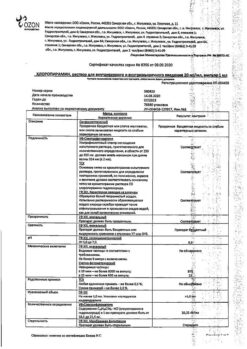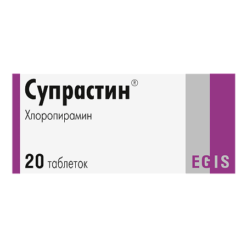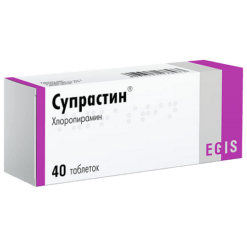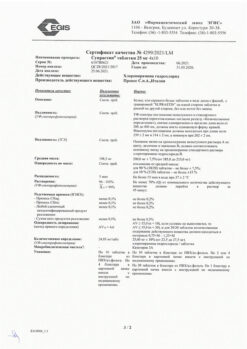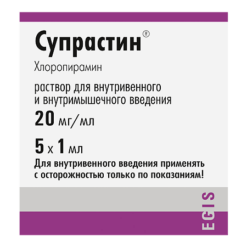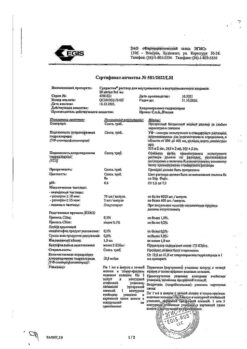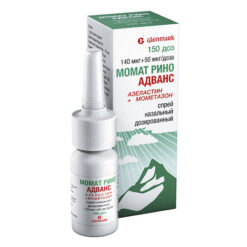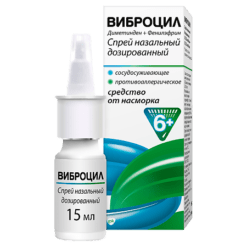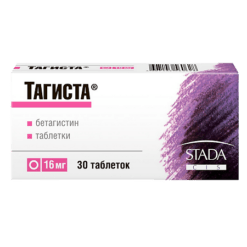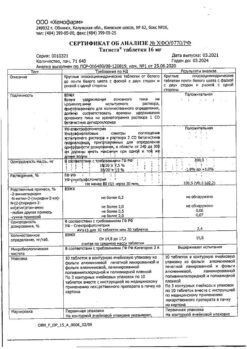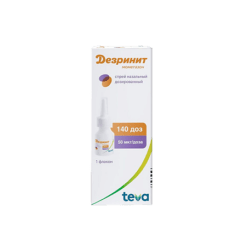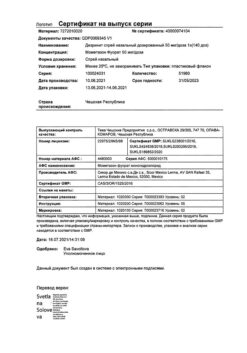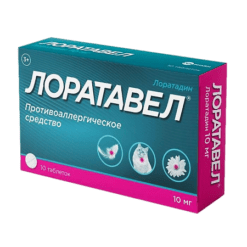No products in the cart.
Chloropyramine, tablets 25 mg 20 pcs
€3.08 €2.00
Description
Pharmacotherapeutic group
anti-allergic agent – Irhistamine receptor blocker
ATC code: D04AA09
Pharmacodynamics:
Chloropyramine, a chlorinated analog of tripelenamine (pyribenzamine), is an antihistamine drug belonging to the group of ethylenediamine antihistamines.
H1-histamine receptor blocker has antihistamine and m-cholinoblocking effects has antiemetic effect moderate antispasmodic and peripheral cholinoblocking activity Pharmacokinetics: When taken orally it is almost completely absorbed from the gastrointestinal tract. The therapeutic effect of chloropyramine develops within 15-30 minutes after oral administration and reaches a maximum during the first hour after ingestion and lasts for at least 3-6 hours. It is well distributed in the body including the central nervous system.
Indications
Indications
Urticaria serum sickness seasonal and year-round allergic rhinitis conjunctivitis contact dermatitis itching acute and chronic eczema atopic dermatitis food and drug allergies allergic reactions to insect bites. Angioedema (as an adjuvant).
Pharmacological effect
Pharmacological effect
Pharmacotherapeutic group
antiallergic agent – Irhistamine receptor blocker
ATX code: D04AA09
Pharmacodynamics:
Chloropyramine, a chlorinated analogue of tripelenamine (pyribenzamine), is an antihistamine belonging to the group of ethylenediamine antihistamines.
The H1-histamine receptor blocker has antihistamine and m-anticholinergic effects, has an antiemetic effect, moderate antispasmodic and peripheral anticholinergic activity
Pharmacokinetics:
When taken orally, it is almost completely absorbed from the gastrointestinal tract. The therapeutic effect of chloropyramine develops within 15-30 minutes after oral administration, reaches a maximum within the first hour after administration and lasts at least 3-6 hours. Well distributed in the body including the central nervous system.
Special instructions
Special instructions
When combined with ototoxic drugs, chloropyramine may mask early signs of ototoxicity. Liver and kidney disease may require a change (reduction) in the dose of the drug. Taking the drug at night may increase the symptoms of reflux esophagitis. The simultaneous use of ethanol (alcoholic beverages) is unacceptable. Long-term use of antihistamines can lead to hematopoietic disorders (leukopenia, agranulocytosis, thrombocytopenia, hemolytic anemia). If during long-term use of the drug there is an unexplained increase in body temperature, laryngitis, pallor of the skin, jaundice, the formation of ulcers in the mouth, the appearance of hematomas, unusual and long-lasting bleeding, it is necessary to conduct an analysis to determine the number of blood elements. If the test results indicate a change in the blood formula, stop taking the drug.
Impact on the ability to drive vehicles. Wed and fur.:
Chloropyramine, especially in the initial period of treatment, can cause drowsiness, fatigue and dizziness. Therefore, in the initial period, the duration of which is determined individually, driving vehicles or performing work associated with an increased risk of accidents is prohibited. After this, the degree of restriction on driving vehicles and operating machinery must be determined by the doctor individually for each patient.
Active ingredient
Active ingredient
Chloropyramine
Composition
Composition
For 1 tablet:
Active substance: chloroniramine hydrochloride – 25.0 mg.
Excipients: lactose monohydrate (milk sugar) – 130.0 mg, microcrystalline cellulose – 32.0 mg, sodium carboxymethyl starch – 5.0 mg, povidone-K25 – 6.0 mg, magnesium stearate – 2.0 mg.
Pregnancy
Pregnancy
Chloropyramine is contraindicated during pregnancy.
If it is necessary to use the drug during lactation, the issue of stopping breastfeeding should be decided.
Contraindications
Contraindications
Hypersensitivity to chloropyramine and other components of the drug, pregnancy, lactation, children under 3 years of age, lactose intolerance, lactase deficiency or glucose-galactase malabsorption, bronchial asthma attack.
With caution:
Angle-closure glaucoma, urinary retention, prostatic hyperplasia, impaired liver and/or kidney function, gastric ulcer in the acute stage, cardiovascular diseases, elderly patients, exhausted patients, respiratory failure, simultaneous use of monoamine oxidase inhibitors (MAOIs) and other drugs that depress the central nervous system.
Side Effects
Side Effects
– From the central nervous system (CNS): drowsiness, weakness, fatigue, dizziness, headache, nervous excitement, tremor, euphoria, impaired coordination of movements, convulsions, encephalopathy.
– From the gastrointestinal tract: abdominal discomfort, pain in the upper abdomen, dry oral mucosa, nausea, vomiting, diarrhea, constipation, loss or increase in appetite.
– From the cardiovascular system: decreased blood pressure, tachycardia, arrhythmia.
– From the organ of vision: blurred visual perception, glaucoma, increased intraocular pressure.
– From the side of hematopoiesis: leukopenia, agranulocytosis, hemolytic anemia and other pathological changes in the cellular composition of the blood.
– Other: difficulty urinating, urinary retention, muscle weakness, photosensitivity, allergic reactions.
If side effects occur, you must stop taking the drug and consult a doctor immediately.
Interaction
Interaction
MAO inhibitors may enhance and prolong the anticholinergic effect of chloroniramine. Enhances the effect of drugs for general anesthesia hypnotics sedative tranquilizers analgesics (including opioids) local anesthetics atropine symnagolytics barbiturates M-anticholinergics. Concomitant use with ethanol is not recommended (risk of severe CNS depression).
Tricyclic antidepressants enhance the m-anticholinergic and depressant effects on the central nervous system.
Caffeine reduces the inhibitory effect on the central nervous system. Antihistamines can prevent the manifestation of a reaction when performing allergy skin tests; therefore, a few days before the planned test, taking drugs of this type should be stopped.
Chloropyramine may mask signs of complications likely during treatment with ototoxic drugs if they are used simultaneously.
Overdose
Overdose
Symptoms: in children – agitation, anxiety, hallucinations, athetosis, incoordination of movement, convulsions, dryness of the oral mucosa, fixed dilated pupils, hyperemia of the facial skin, sinus tachycardia, urinary retention, fever, then – vascular collapse, coma. In adults – lethargy, anxiety, impaired coordination of movement, depression, hyperthermia and hyperemia of the skin, psychomotor agitation, convulsions, post-convulsant depression, coma.
Treatment: up to 12 hours after taking the drug, gastric lavage is necessary (it should be taken into account that gastric emptying is prevented by the anticholinergic effect of the drug). The use of activated carbon is indicated (during detoxification in the early stages after oral administration). Monitoring of blood pressure and breathing parameters is necessary. Symptomatic therapy (including the prescription of antiepileptic drugs caffeine) resuscitation measures artificial ventilation – according to indications. There is no specific antidote.
Storage conditions
Storage conditions
In a place protected from light at a temperature not exceeding 25 ° C. Keep out of the reach of children.
Shelf life
Shelf life
3 years. Do not use after expiration date.
Manufacturer
Manufacturer
Ozon, Russia
Additional information
| Shelf life | 3 years. Do not use after the expiration date. |
|---|---|
| Conditions of storage | Store in a dark place at a temperature not exceeding 25 °С. Keep out of reach of children. |
| Manufacturer | Ozon, Russia |
| Medication form | pills |
| Brand | Ozon |
Other forms…
Related products
Buy Chloropyramine, tablets 25 mg 20 pcs with delivery to USA, UK, Europe and over 120 other countries.

